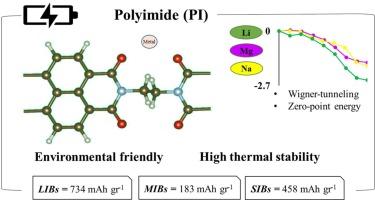解释聚酰亚胺作为镁、钠和锂离子电池的绿色电极材料:DFT和AIMD方法
IF 4.6
3区 材料科学
Q2 MATERIALS SCIENCE, MULTIDISCIPLINARY
引用次数: 0
摘要
本文采用密度泛函理论(DFT)计算研究了聚酰亚胺在Mg、Li和na离子电池(MIBs、LIBs和SIBs)中的应用。带结构计算表明,Mg的吸附减小了衬底的带隙,而Li和Na的吸附使其从半导体转变为金属。mib / lib / sib的理论容量分别为183.56/734.27/458.92 mAh/g。充分吸附的配合物在600 K时表现出热力学稳定性和热稳定性。Mg/Li/Na的平均开路电压(OCV)分别为0.15/0.81/0.78 V,均在电池的合适电压范围内。扩散能势垒分析显示羰基周围没有离子迁移的势垒。Li和Na沿六方环扩散,势垒分别为0.39 eV和0.14 eV。零点能量(ZPE)、Wigner和Wigner隧穿修正表明Li具有隧穿效应。这些发现表明,聚酰亚胺是一种可行的阳极材料,用于高容量mib、lib和sib。本文章由计算机程序翻译,如有差异,请以英文原文为准。

Explanation of polyimide as a green electrode material for Mg-, Na- and Li-ion batteries: DFT and AIMD approach
In this work, Density Functional Theory (DFT) calculations were employed to investigate the polyimide application in Mg, Li, and Na-ion batteries (MIBs, LIBs, and SIBs). Band structure calculations demonstrate that Mg adsorption reduced the substrate’s band gap, while Li and Na adsorption transformed it from semiconducting to metallic. Theoretical capacities for MIBs/LIBs/SIBs were calculated at 183.56/734.27/458.92 mAh/g. The fully adsorbed complexes exhibited thermodynamic stability and thermal stability at 600 K. The average open-circuit voltages (OCV) for Mg/Li/Na were 0.15/0.81/0.78 V, respectively, falling within the appropriate voltage range for these batteries. Diffusion energy barrier analysis revealed no barrier for ions migrating around the carbonyl group. Additionally, Li and Na diffused along hexagonal rings with barriers of 0.39 eV and 0.14 eV, respectively. Zero-point energy (ZPE), Wigner, and Wigner-tunneling corrections indicated a tunneling effect for Li. These findings suggest polyimide as a viable anode material for high-capacity MIBs, LIBs, and SIBs.
求助全文
通过发布文献求助,成功后即可免费获取论文全文。
去求助
来源期刊

Materials Science and Engineering: B
工程技术-材料科学:综合
CiteScore
5.60
自引率
2.80%
发文量
481
审稿时长
3.5 months
期刊介绍:
The journal provides an international medium for the publication of theoretical and experimental studies and reviews related to the electronic, electrochemical, ionic, magnetic, optical, and biosensing properties of solid state materials in bulk, thin film and particulate forms. Papers dealing with synthesis, processing, characterization, structure, physical properties and computational aspects of nano-crystalline, crystalline, amorphous and glassy forms of ceramics, semiconductors, layered insertion compounds, low-dimensional compounds and systems, fast-ion conductors, polymers and dielectrics are viewed as suitable for publication. Articles focused on nano-structured aspects of these advanced solid-state materials will also be considered suitable.
 求助内容:
求助内容: 应助结果提醒方式:
应助结果提醒方式:


